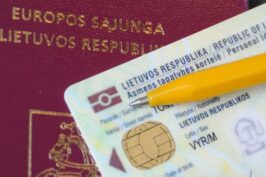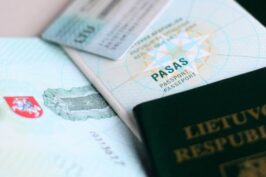- Home
- Loss of Lithuanian citizenship before 15 June 1940
Loss of Lithuanian citizenship before 15 June 1940


The grounds for the loss of Lithuanian citizenship were established in the Lithuanian Constitutions of 1922, 1928, 1938, also, in the Provisional Law on Lithuanian Citizenship of 09 January 1919, and in the Law on Lithuanian Citizenship of 08 August 1938. The Lithuanian citizenship could be lost on acquiring citizenship of another state, moreover, when residing abroad for more than two years without a foreign passport or with an invalid foreign passport.
The Provisional Law on Lithuanian Citizenship did not establish that a person who acquired citizenship of another state should lose Lithuanian citizenship. The principle of inadmissibility of dual citizenship was firstly consolidated in the Constitution of the Republic of Lithuania of 1922, wherein it was stipulated that “Nobody can be a citizen of Lithuania and a citizen of another state at the same time” (Article 9). The analogous provision was entrenched in the first paragraph of Article 10 of the Constitution of the State of Lithuania of 1928, wherein it was specified that “Nobody can be a citizen of Lithuania and a citizen of another state at the same time”. Nevertheless, the second paragraph of this Article has made an exception clause: “A Lithuanian citizen shall not lose his/her citizenship rights when becoming a citizen of any American region, if he/she performs certain obligations provided for by law.”
An official note of the Ministry of the Interior of 21 March 1935 stated that “The Lithuanian citizen by acquiring citizenship of another state shall not lose Lithuanian citizenship, if he/she has not withdrawn from the Lithuanian citizenship in accordance with the relevant procedure, thus, having received a consent of the Ministry of the Interior to withdraw from the Lithuanian citizenship.”
It has been established in Article 10 of the Constitution of 15 May 1928 that the Lithuanian citizen who has become a citizen of any American region shall not lose his/her citizenship rights, provided he/she performs certain obligations laid down by law. It should be noted that although in accordance with the specified constitutional provision the Lithuanian citizen did not lose his/her citizenship rights only if he/she “performs certain obligations provided for by law”, however, laws did not establish what obligations must be fulfilled by the person in order to retain the held Lithuanian citizenship. Therefore, the Lithuanian citizen, after acquiring citizenship of any American region, was considered not to have lost the Lithuanian citizenship. Such person was not required to perform any duties in order to be treated the Lithuanian citizen. Nevertheless, persons who acquired citizenship of any American region and retained the held Lithuanian citizenship were not allowed to have two passports at the same time: in such cases when “Lithuanian citizen after becoming a citizen of any American region and later on settling in Lithuania requests to issue him/her the Lithuanian internal passport, request thereof must be satisfied according to the rules for internal passports, <…> his/her American passport must be stored in the internal passport issuance file without annulment thereof, and it must be returned, at the request of the holder, clean and in such case the issued internal passport must be deprived and kept in the file.”
On the other hand, the constitutional provision that the Lithuanian citizen shall not lose Lithuanian citizenship after becoming a citizen of any American region was understood in a way that the held Lithuanian citizenship shall be retained only by such person who was Lithuanian citizen before an acquisition of citizenship of any American region. Persons who acquired citizenship of any American region by birth could not be issued with the Lithuanian internal passports.
Dual citizenship issues were discussed much more clearly in the Lithuanian Constitution of 1938. It has been established in paragraph 1 of Article 13 of the Constitution that “a citizen who acquired foreign citizenship shall lose the Lithuanian citizenship.” Thus, the principle of prohibition of dual citizenship was consolidated. Nevertheless, this prohibition was not absolute: it was specified in paragraph 2 of this Article that “in cases provided for by law, a citizen having a foreign citizenship may not cease Lithuanian citizenship.”
The provision that the Lithuanian citizenship shall be lost “after accepting citizenship of foreign state” was also set out in the Law on Lithuanian Citizenship, as of 08 August 1938 (paragraph 1, Article 20). In accordance with Article 21 of this Law, “Lithuanian citizen, having accepted citizenship of foreign state, shall be allowed to retain Lithuanian citizenship with the permission of the Minister of the Interior.” The laws did not specify other cases (except for the indicated permission of the Minister of the Interior) when the Lithuanian citizen, having accepted citizenship of another state, could also preserve the held Lithuanian citizenship.
The cases when the Lithuanian citizenship used to be lost after acquisition of citizenship of another state also embraced such cases when the Lithuanian citizenship was lost by a woman, “if she married a foreigner and hereby acquired citizenship of her husband.”
Attention should be drawn to the fact that a person willing to acquire citizenship of another state had to obtain acquittance from the Lithuanian citizenship. This institute was established neither in the Provisional Law on Lithuanian Citizenship, nor in any other law. Formation thereof was influenced by the fact that the Provisional Law on Lithuanian Citizenship did not provide for the person’s right to renounce Lithuanian citizenship. Such legal regulation caused problems to those Lithuanian citizens who wanted to acquire citizenship of another state when laws of such state forbade dual citizenship and when a person was requested to provide evidence that a person no longer was a citizen of “former” state thereof. The practice gradually formed that the Lithuanian citizen willing to acquire citizenship of another state had to submit an application to the Ministry of the Interior for acquittance from the Lithuanian citizenship.
The persons willing “to withdraw from the Lithuanian citizenship” had to submit applications to the county governor, and those living abroad – to the diplomatic mission or consulate of the Republic of Lithuania.
The issuance of the document of withdrawal from the Lithuanian citizenship alone did not mean that a person lost Lithuanian citizenship thereupon. A person was considered the Lithuanian citizen until he/she acquired citizenship of another state.
It should be noted that a declaration that a statutory basis has arisen was not enough for the loss of Lithuanian citizenship. The person was considered to have lost Lithuanian citizenship only then, when the Council of Ministers adopted a decision regarding the loss of Lithuanian citizenship. Such decision could be adopted by the Council of Ministers only on a proposal of the Minister of the Interior.
Information source: V. Sipavičius “Citizenship of the Republic of Lithuania in 1918-2001”
Read more:
MIGRATION LAW CENTER






























